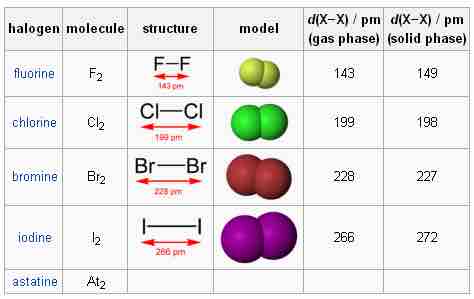Overview
The halogens are nonmetallic elements in Group 17 of the periodic table. They include fluorine, chlorine, bromine, iodine, and astatine. Ununseptium, which is not a naturally occurring element, is also often considered a halogen. As typical nonmetals, they have low melting and boiling points. A unique characteristic of halogens is that they are the only element group that includes elements that belong to all three classical states of matter: solid, liquid, and gas at room temperature.

Properties of the halogen group
Typical properties of the halogens.
The halogens, as a group, are extremely reactive. In their elemental form, they are found as diatomic molecules. However, due to their extremely high reactivity (electronegativity), they are not found in their elemental form in any natural environment on Earth.
Safety and Storage for Elemental Halogens
Halogens are generally toxic, or even lethal, to biological organisms in their elemental forms. They tend to combine readily, and explosively, with metals, particularly with alkali metals. Fluorine is one of the most reactive elements in existence, attacking otherwise inert materials, such as glass, and forming compounds with the heavier noble gases. It is a corrosive and highly toxic gas. The reactivity of fluorine is such that if it is used or stored in laboratory glassware, it can react with glass in the presence of small amounts of water to form silicon tetrafluoride (SiF4). Therefore, fluorine must be handled with substances such as Teflon (which is itself an organofluorine compound), extremely dry glass, or metals such as copper or steel that form a protective layer of fluoride on their surface. The high reactivity of fluorine also means that once it does react with something, it bonds with it so strongly that the resulting molecule is very inert and non-reactive to anything else. For example, Teflon is a polymer of fluorine bonded with carbon.

The halogens
The halogens are highly reactive, diatomic molecules.
Reactivity of Halogens
The halogens all form binary compounds with hydrogen, known as the hydrogen halides: hydrogen fluoride (HF), hydrogen chloride (HCl), hydrogen bromide (HBr), hydrogen iodide (HI), and hydrogen astatide (HAt). All of these are strong acids when dissolved in water, with the exception of HF. However, hydrofluoric acid is quite destructive to animal tissue. When in aqueous solution, the hydrogen halides are known as hydrohalic acids. The names of these acids are as follows: hydrofluoric acid, hydrochloric acid, hydrobromic acid, and hydroiodic acid. All of these acids must be handled with great care because they are extremely dangerous. Some of these acids are also widely used in industry. The halogens can also react with each other to form interhalogen compounds.
Reactivity of Halogens and Water
Fluorine reacts vigorously with water to produce oxygen (O2) and hydrofluoric acid (HF):
Chlorine has a maximum solubility of about 7.1 g Cl2/kg H2O at ambient temperature (21 °C). Dissolved chlorine reacts to form hydrochloric acid (HCl) and hypochlorous acid (HClO), a solution that can be used as a disinfectant or bleach:
Bromine has a solubility of 3.41 g/100 g H2O, but it slowly reacts to form hydrogen bromide (HBr) and hypobromous acid (HBrO):
Iodine, however, is minimally soluble in water (0.03 g/100 g H2O at 20 °C) and does not react with it. However, iodine will form an aqueous solution in the presence of iodide ions, such as with the addition of potassium iodide (KI), because the triiodide ion (I3-) is formed.